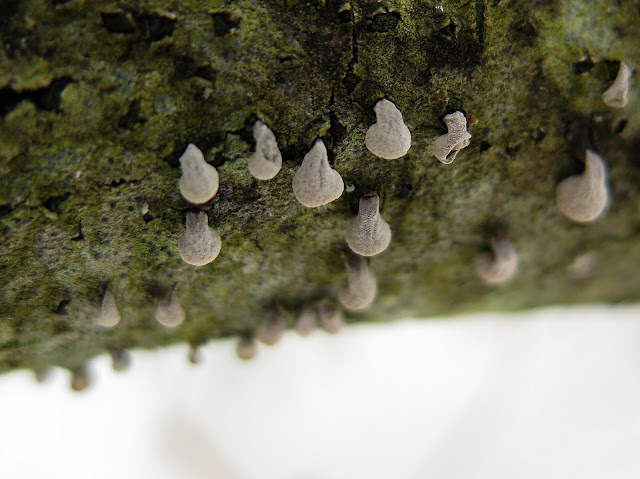Oh, we've had some lovely snow since I last posted here, nearly ten inches of pristine fluff, but because of a knee-pain issue I did not venture out on snowshoes to enjoy it. But I did venture out on Saturday, the day before the most recent deep snowfall, to join my friends Sue and Dana for a walk around Mud Pond at Moreau Lake State Park. The snow on the trail was packed without being icy, so we needed neither snowshoes nor ice grippers to stride along, enjoying the views of the snow-covered frozen pond, distant mountains, and beautiful blue sky.
Because of a large population of beavers that make Mud Pond their home, we stayed to the trail, rather than venture out on the ice. Although we could see a lodge on the pond, I am also aware that beavers also burrow into the steep banks that ring this pond, keeping patches of open water near the entrances to their dens. We noticed the open water or water-covered ice near their lodge out on the pond.
Our pond-side striding often came to a halt, for many eye-catching organisms did catch our eyes. This massive population of Violet-tooth Polypore (Trichaptum biforme) was especially striking, with snaking pillars of stacked striped caps emerging from every fissure in the bark of a trailside tree.
Many sapling oaks line the trail, and since oaks are among the most frequent hosts to numerous kinds of galls, we were treated to several of them. This one looked like a frozen powder puff, and suggested to me that it might be the remains of the furry gall produced by the Wool Sower Wasp, a distinctive plant growth induced by the secretions of the grubs of this tiny wasp, Callirhytis seminator.
Here were more galls on a second oak sapling, these clustered spheres resembling bunches of grapes.
Even dead and dying trees offered instances of beauty, such as this marvelous mix of fungi and lichens ornamenting a broken-off twig, probably of a conifer.
Thanks to Sue's way around the iNaturalist site, we now know that this group of itty-bitty fungi occupying a fallen treelimb is Porodisculus pendulus. This fungus has no known vernacular name, but the Latin name is perfectly descriptive of a fungus that is pendulous (hanging downward) and with tiny pores on the underside of its rather wrinkly whitish discs. Sue noted that there weren't too many reports of it on iNat, nor any mention of it in her mushroom books. That sent her to searching for it on Google, where more than one web hit described it as "The World's Smallest Polypore." A little bit bigger than the head of a pin. But not much. Easily overlooked, I would bet, because of its tiny size.
This little twig had broken off a dead limb and was lying atop the snow. I do not know the name of the shaggy green moss with its minute spore stalks, I simply found it cunning and cute enough to take its picture.
I DO know the name of the tree that bore these vibrantly red twigs. It's Striped Maple (Acer pensylvanicum), and I find twigs of such vibrancy only in winter. And not all specimens of Striped Maple produce twigs of this color, even in winter. Often, the twigs are a dark bronzy green. According to one source on Google, the twigs "turn vivid red in winter due to the presence of anthocyanin pigments, which are produced in the bark as a response to cold temperatures, giving the twigs their striking red color, especially noticeable during the winter months when leaves are absent; this is a natural protective mechanism against harsh conditions." Yeah, but not all Striped Maple twigs in the same forest do this.

Passing an area where I know that throngs of Mapleleaf Viburnum (Viburnum acerifolium) grow, I found that many shrubs still held clusters of the fruit that matured in autumn. Because the berries's seeds are so large, the fruit is ignored by wildlife until all other, more palatable fruits are gone.
And as far as I know or can discover, the fruits of Maleberry (Lyonia ligustrina) don't appear to be eaten by any wild animal, but remain on the shrubs until they produce these hard and dry pods that will eventually shed the seeds within. I think the little pods are quite pretty, with their star-shaped openings.
Much of the land surrounding Mud Pond is populated with both White Pines and Pitch Pines, and the needle-carpeted soil beneath those pines is quite sandy. This is exactly the habitat preferred by the Pink Lady's Slipper (Cypripedium acaule), and that beautiful native orchid abounds here in May. Even in winter, we can find evidence of their presence, with fat pods atop slender stalks protruding from the snow.

Finding this evidence that gorgeous pink orchids will be blooming here in spring, I carry that expectation with me tomorrow (February 11), when I will be receiving total knee replacement surgery. I am hoping that by the time the Pink Lady's Slippers flower in spring, I can wander these woods without the pain that has hobbled me ever since I smashed my kneecap 10 years ago. Since I probably won't be having new woods or waterways adventures for a few weeks to come, I probably won't be producing new posts for this blog in the meantime. But with more than 16 years' worth of blogposts, I think I might find some posts among the more than 2,000 in blog archive that might be worth a second look and read. So, dear readers, stay tuned to see what treasures I might dig up from the comforts of my couch.






























